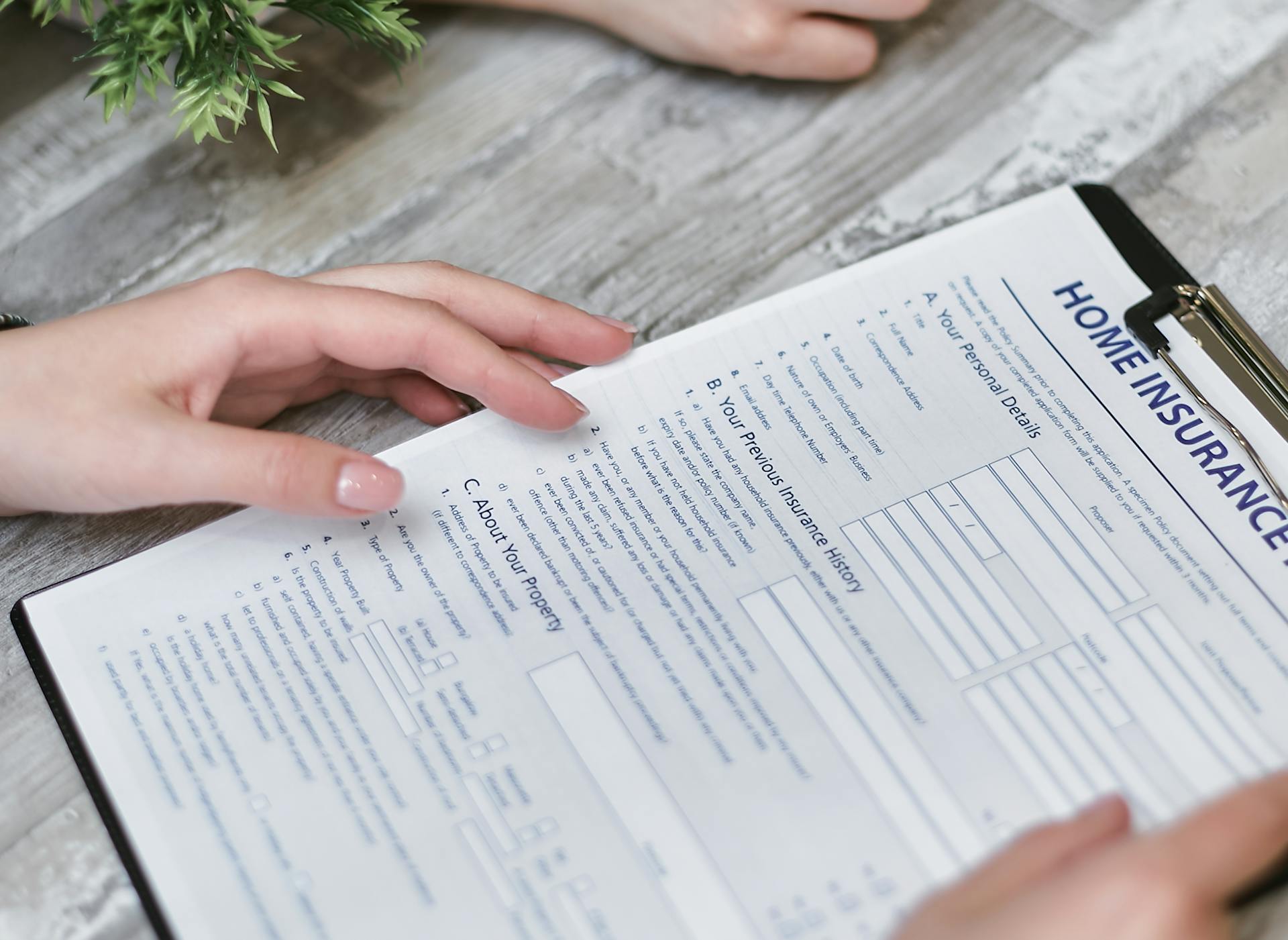
Depreciation expense adjusting entries can be a bit tricky, but understanding the basics is key.
The main purpose of a depreciation expense adjusting entry is to match the cost of a tangible asset with the revenue it generates over its useful life.
Depreciation is calculated using the straight-line method, which is a simple and straightforward approach.
The asset's useful life is determined by its expected usage and lifespan.
For example, a company purchases a machine that is expected to last for 5 years.
Intriguing read: Prior to the Adjusting Process Accrued Revenue Has
Calculating Depreciation
Calculating depreciation is a straightforward process that involves a few key pieces of information. To start, you need to know the cost of the asset, which includes the purchase price and any additional costs such as shipping, taxes, and installation.
The depreciation method is also important, with straight-line depreciation being the easiest to calculate. This method involves dividing the cost of the asset by its useful life to determine the annual depreciation expense. For example, if a laptop costs $1,000 and has a useful life of 5 years, the annual depreciation expense would be $200.
Consider reading: Direct Costs
You'll also need to know the useful life of the asset, which can vary depending on the type of asset. Common useful lives include 5 years for computers and 7 years for office furniture.
The residual value, or salvage value, of the asset is also important. This is the estimated value of the asset at the end of its useful life. In some cases, the residual value may be ignored, but it's worth considering when calculating depreciation.
Here are the key factors to consider when calculating depreciation:
- Cost: The purchase price and any additional costs
- Depreciation method: Straight-line or accelerated depreciation
- Useful life: The length of time the asset can be used
- Residual value: The estimated value of the asset at the end of its useful life
For example, let's say a delivery van costs $40,000 and has a useful life of 5 years. If the residual value is $10,000, the annual depreciation expense would be calculated as follows:
Historical Cost - Residual Value
Estimated Useful Life
$40,000 - $10,000
5 years
This would result in an annual depreciation expense of $6,000.
Here's an interesting read: Calculating Annual Depreciation Expense
Recording Depreciation
Recording depreciation is a crucial step in accounting for the wear and tear of assets over time. You record depreciation as a debit to a depreciation expense account and a credit to a contra asset account called accumulated depreciation.

Depreciation expense shows up in the income statement, while accumulated depreciation is grouped with the fixed assets on the balance sheet. The bookkeeping entry to record depreciation is made every month until the balance in the accumulated depreciation account equals the purchase price or until the asset is disposed of.
The entry to record depreciation expense is simple: debit Depreciation Expense and credit Accumulated Depreciation. For example, if the depreciation expense is $6,000, the entry would be:
Accumulated depreciation is a contra-asset account that reduces the book value of an asset on the balance sheet. The net book value of an asset is determined by adding the fixed asset account and the accumulated depreciation account.
To illustrate, here's a table showing the computation of the carrying value of a delivery van for each year of its useful life:
Notice that at the end of the useful life of the asset, the carrying value is equal to the residual value.
Depreciation Adjusting Entries

The journal entry for depreciation expense is a debit to the Depreciation Expense account and a credit to the Accumulated Depreciation account. This entry is made at the end of each accounting period.
To record depreciation expense, a company uses the units-of-production method, which involves calculating the depletion cost per unit and then multiplying it by the number of units used during the period. For example, if a company has a tract of land containing ore deposits and estimates that 900,000 tons can be removed economically, and the total cost is $900,000, the unit depletion charge would be $1 per ton.
The debit entry is made to the Depreciation Expense account, and the credit entry is made to the Accumulated Depreciation account. The entry would be: Debit Depreciation Expense $100,000, Credit Accumulated Depletion—Ore Deposits $100,000.
Here's a table illustrating the computation of the carrying value of the delivery van for each year of its useful life:
The accumulated depreciation account is a contra-asset account, which means it is an asset account with a credit balance. It is presented in the balance sheet as a deduction to the related fixed asset.
Journalizing Adjusting Entries

Journalizing Adjusting Entries involves recording depreciation expense and accumulated depreciation in the general ledger. This is typically done at the end of each accounting period.
To record depreciation expense, you debit Depreciation Expense and credit Accumulated Depreciation. This is recorded at the end of the period, usually monthly, quarterly, or yearly.
The entry to record the $6,000 depreciation every year would be:
The Depreciation Expense account is a temporary account, and its balance is carried over to the next accounting period. On the other hand, Accumulated Depreciation is a contra-asset account that represents the accumulated balance of depreciation.
The net book value of an asset is determined by taking the sum of the fixed asset account and the accumulated depreciation account. Over time, the net book value of an asset will decrease until its salvage value is reached.
Here's a table illustrating the computation of the carrying value of the delivery van for each year of its useful life:
Notice that at the end of the useful life of the asset, the carrying value is equal to the residual value.
Disposal of Property or Equipment
Recording the disposal of property or equipment is relatively straightforward.
To establish account balances that are appropriate as of the date of sale, depreciation is recorded for the period of use during the current year. This matches the expense with the revenues earned in the current period.
The amount received from the sale is recorded while the net book value of the asset is removed. If the owner receives less for the asset than net book value, a loss is recognized for the difference.
A loss of $82,000 is reported by the seller if the building is sold for $290,000 on December 31, Year Two, when the net book value is $372,000. The journal entry for this loss is recorded after the depreciation adjustment for the period is made.
If the building is sold for more than net book value, the excess is recorded as a gain. A gain of $68,000 is recognized if the building is sold for $440,000 rather than $290,000.
Gains and losses such as these appear on the income statement, often shown separately from revenues and expenses. This allows a decision maker to determine both the income derived from primary operations and the amount that resulted from tangential activities.
Recommended read: What Is Prior Year Accumulated Depreciation
Example and Practice
Let's practice recording depreciation expense adjusting entries with some examples. The XYZ Ltd company bought a cake baking oven for $15,000 with a 10-year useful life, and the annual depreciation expense is $1,500.
To calculate the annual depreciation expense, we use the formula: Annual depreciation expense = (Cost of the asset – Salvage value of the asset) / Useful life. This formula helps us determine how much of the asset's value will be expensed each year.
The Lombardi Company buys equipment for $2 million with an expected 20-year life and a residual value of $100,000. Using the same formula, the depreciable basis for this asset is $1.9 million ($2 million cost less $100,000 estimated residual value).
The straight-line method is used to determine depreciation expense, which means the annual depreciation expense is $95,000 ($1.9 million/20 years). After three years, the accumulated depreciation is $285,000 ($95,000 × 3).
The company sells the equipment for $1.8 million, and we can calculate the gain recognized on this sale by subtracting the net book value from the sale price. The net book value is $1,715,000 ($2 million cost less $285,000 accumulated depreciation), so the gain is $85,000 ($1.8 million received less $1,715,000 book value).
Frequently Asked Questions
What are the 5 adjusting entries?
Adjusting entries are categorized into five main types: accrued revenues, accrued expenses, unearned revenues, prepaid expenses, and depreciation. These entries help ensure financial accuracy by matching revenues and expenses with the correct period.
Sources
- https://floqast.com/blog/fixed-asset-depreciation-journal-entry/
- https://www.accountingverse.com/accounting-basics/depreciation-expense.html
- https://www.wallstreetmojo.com/depreciation-journal-entry/
- https://2012books.lardbucket.org/books/business-accounting/s13-03-recording-depreciation-expense.html
- https://courses.lumenlearning.com/suny-finaccounting/chapter/journalizing-adjusting-entries-for-depletion-and-depreciation/
Featured Images: pexels.com


